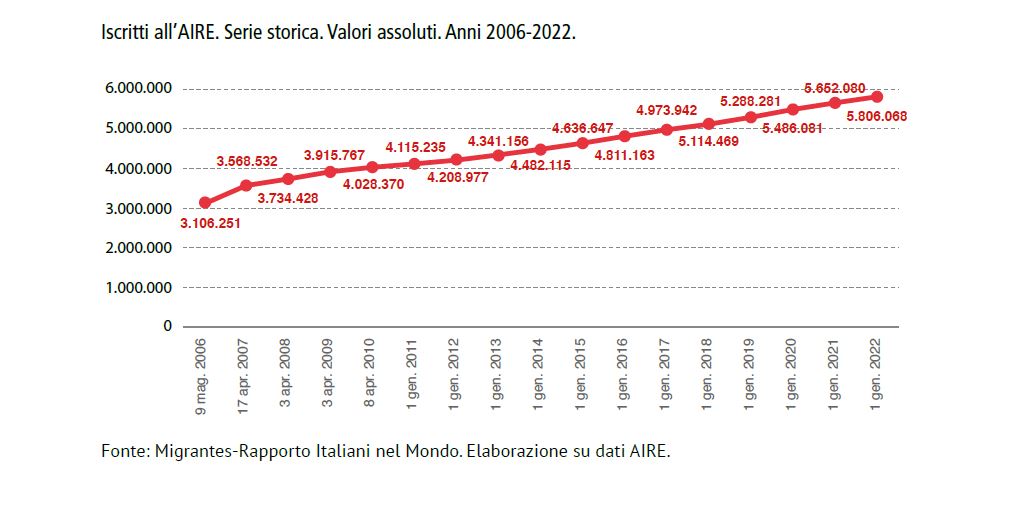
“An inter-cultural Italy in which 8.8% of its registered residents are non-Italians ( almost 5.2 million in absolute terms), while 9.8% of Italian citizens live abroad (over 5.8 million).”
The first snapshot of Italy is contained in the ‘Italians in the World Report 2022’ (RIM), now in its seventeenth edition, was presented in Rome today by the Migrantes Foundation, under the direction of Delfina Licata. The 2022 Special Edition Report focuses primarily on COMITES Representatives – i.e. Committees of Italians living abroad.
“The foreign national population resident in Italy is younger than the Italian one”,
reads the Report: in fact, “young people born in Italy to immigrant parents (‘second generation’ in the strict sense) number over 1 million: of these, 22.7% (over 228,000) have obtained Italian citizenship. If to these numbers are added foreign-born (about 245,000) and naturalised citizens (almost 62,000), the total number of children with a migratory background rises to over 1.3 million, accounting for 13.0% of Italy’s under-18 resident population.” A “very precious population”, notes the Report, “given Italy’s dramatic demographic trends, marked by collapsing birth-rates and relentless ageing population, along with the fact that the younger generations dream of living in other parts of the world, with as many as 59% of all secondary school pupils of foreign origin wishing to emigrate to other countries when they grow up, significantly more than their Italian peers (42%)”.
In addition to being intercultural,
Italy is also becoming increasingly transnational.
“Italian communities abroad comprise more than 841,000 minors (14.5% of the total number of Italian nationals registered with AIRE – the Registry of Italians Residing Abroad), with many foreign-born and many more having left with their families over the past few years,” the Report states. In addition to minors, AIRE registered residents include “over 1.2 million 18-34 year-olds (21.8% of the overall AIRE registered population, accounting for approximately 42% of total number of departures each year for expatriation purposes alone)” in addition to “all those individuals leaving for education purposes and vocational training programmes – not required to register with AIRE – and those residing irregularly abroad due to non-compliance with statutory registration requirements.”
Hence, a young population that leaves and never returns, due to Italy’s youth employment rate of 29.8% for 15-29 year-olds in the year 2020, a far cry from the employment rates of other European countries (46.1% for the EU27 in 2020) and with a 43 percentage point difference compared to adults aged 45-54.
In the years 2006-2022 Italian mobility increased by 87% as a whole, by 94.8% for women, by 75.4% for minors, while residents leaving Italy for ‘expatriation reasons’ alone grew by 44.6%.
Youth mobility is increasing because Italy has been keeping young people trapped for years in “quality and competence reserves” that they could tap into, but the right time never comes.
“Two Italies”. One Italy – made of its residents and workers within its national borders – registered plummeting birth rates, while another Italy, increasingly active and dynamic, is gazing at those same borders from afar.
As of January 1, 2022, there were 5,806,068 Italian citizens registered with AIRE – representing 9.8% of more than 58.9 million citizens residing in Italy.
While Italy has lost 0.5% of its resident population in one year (down 1.1% since 2020), the number of Italians living abroad increased by 2.7% in the past 12 months – a total of 5.8% compared to 2020. In absolute terms, there were almost 154,000 new registrations abroad as opposed to over 274,000 residents ‘lost’ in Italy. The global growth rate of Italian residents abroad was lower last year, both in total numbers and in percentage terms, compared to previous years. As many as 48.2% of over 5.8 million Italian citizens residing abroad were women (about 2.8 million in absolute terms), the Report found.
 Italian citizens registered with AIRE – (who transferred their residency abroad) – in the years 2006-2022 increased by 134.8% (amounting to over just over 190,000 Italian citizens; they numbered almost 81,000 in 2006). The number of Italians born abroad grew by 167.0% since 2006 ( totalling 2,321,402; they numbered 869,000 in 2006).
Italian citizens registered with AIRE – (who transferred their residency abroad) – in the years 2006-2022 increased by 134.8% (amounting to over just over 190,000 Italian citizens; they numbered almost 81,000 in 2006). The number of Italians born abroad grew by 167.0% since 2006 ( totalling 2,321,402; they numbered 869,000 in 2006).
These Italians convey a multi-faceted portrait of our country, which makes it intercultural and increasingly transnational, i.e. made up of Italians with various origins (born and/or raised in countries other than Italy or born in Italy to families who moved from distant countries), moving comfortably across (at least) two countries, speaking several languages, inhabiting many cultures.
The over 5.8 million Italians registered with AIRE present a varied profile consisting of young people (21.8% are 18-34 year-olds), young adults (23.2% 35-49 year-olds), older adults (19.4% 50-64 year-olds), senior citizens (21% aged 65 and older, of which 11.4% are older than 75) and children (14.5% are less than 18 years-old).
More than 2.7 million (47.0%) emigrated from the south of Italy (of these, approximately 936,000, 16%, left from Sicily or Sardinia); more than 2.1 million (37.2%) emigrated from the north of Italy while 15.7% were originally living in central Italy. 54.9% of Italians (almost 3.2 million) moved to other European countries, 39.8% (more than 2.3 million) to America, mostly Central and South America (32.2%, or over 1.8 million). Italian nationals are present in all the countries of the world. The largest communities to date are those in Argentina (903,081), Germany (813,650), Switzerland (648,320), Brazil (527,901) and France (457,138).
The long wave of the pandemic slowed down Italian mobility.
A total of 195,466 Italian citizens registered with AIRE in the period January – December 2021, down 12.1% compared to the same period a year earlier, when they totalled 222,260 overall. Departures for ‘expatriation’ purposes during the year 2021 totalled 83,781, the lowest recorded number since 2014, when they exceeded 94,000.
In fact, the upward trend had come to a halt last year, when the number of departures still remained steadily over 109,000. It was therefore a mild decline, which, however, became a sharp one in the following twelve months. The trends projected to affect Italian mobility in 2020 occurred in 2021: in other words, the pandemic influenced the overall mobility of Italian nationals, drastically decreasing its volume and, once again, transforming its profile. With respect to 2021, there were 25,747 fewer registrations, representing a 23.5% drop in one year, and a 36.0% decline compared to 2020. The decrease equally involved men (-23.0%) and women (-24.0%), amounting, in absolute terms, to over 47,000 and almost 38,000, respectively.









